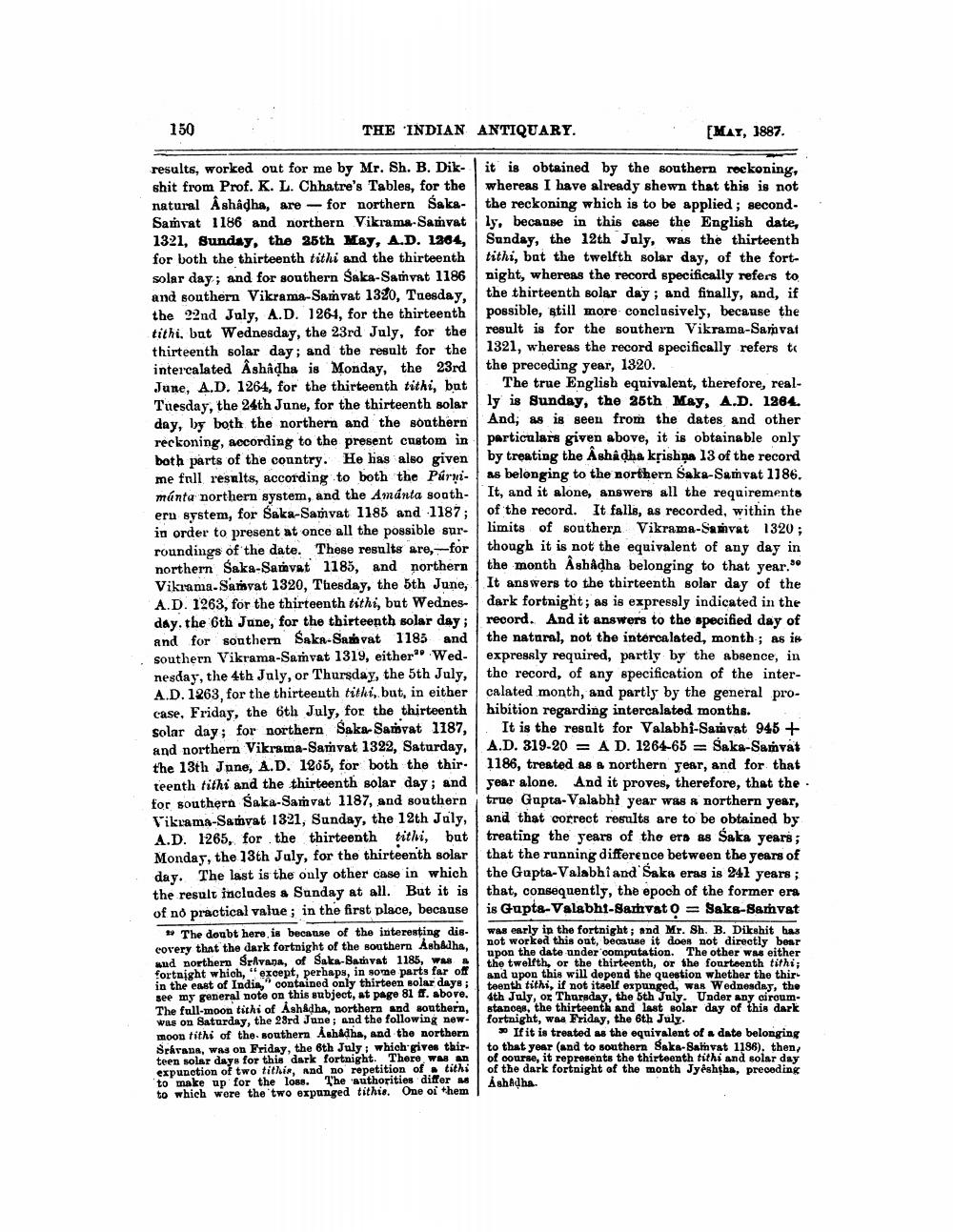________________
150
results, worked out for me by Mr. Sh. B. Dikshit from Prof. K. L. Chhatre's Tables, for the natural Ashadha, are for northern SakaSamvat 1186 and northern Vikrama Samvat 1321, Sunday, the 25th May, A.D. 1264, for both the thirteenth tithi and the thirteenth solar day; and for southern Saka-Samvat 1186 and southern Vikrama-Samvat 1320, Tuesday, the 22nd July, A.D. 1261, for the thirteenth tithi, but Wednesday, the 23rd July, for the thirteenth solar day; and the result for the intercalated Ashadha is Monday, the 23rd June, A.D. 1264, for the thirteenth tithi, but Tuesday, the 24th June, for the thirteenth solar day, by both the northern and the southern reckoning, according to the present custom in both parts of the country. He has also given me full results, according to both the Purimánta northern system, and the Amánta soathern system, for Saka-Samvat 1185 and 1187; in order to present at once all the possible surroundings of the date. These results are, for northern Saka-Samvat 1185, and northern Vikrama-Samvat 1320, Tuesday, the 5th June, A.D. 1263, for the thirteenth tithi, but Wednesday. the 6th June, for the thirteenth solar day; and for southern Saka-Samvat 1185 and southern Vikrama-Samvat 1319, either" Wednesday, the 4th July, or Thursday, the 5th July, A.D. 1263, for the thirteenth titki, but, in either case, Friday, the 6th July, for the thirteenth solar day; for northern Saka-Samvat 1187, and northern Vikrama-Samvat 1322, Saturday, the 13th June, A.D. 1265, for both the thirteenth tithi and the thirteenth solar day; and for southern Saka-Samvat 1187, and southern Vikrama-Samvat 1321, Sunday, the 12th July, A.D. 1265, for the thirteenth tithi, but Monday, the 13th July, for the thirteenth solar day. The last is the only other case in which the result includes a Sunday at all. But it is of no practical value; in the first place, because
THE INDIAN ANTIQUARY.
[MAY, 1887.
it is obtained by the southern reckoning, whereas I have already shewn that this is not the reckoning which is to be applied; secondly, because in this case the English date, Sunday, the 12th July, was the thirteenth tithi, but the twelfth solar day, of the fortnight, whereas the record specifically refers to the thirteenth solar day; and finally, and, if possible, still more conclusively, because the result is for the southern Vikrama-Samvat 1321, whereas the record specifically refers to the preceding year, 1320.
The doubt here, is because of the interesting discovery that the dark fortnight of the southern Ashadha, and northern Sravana, of Saka-Samvat 1185, was a fortnight which, "except, perhaps, in some parts far off in the east of India," contained only thirteen solar days; see my general note on this subject, at page 81 ff. above. The full-moon tithi of Ashadha, northern and southern, was on Saturday, the 23rd June; and the following newmoon tithi of the southern Ashadha, and the northern Srávana, was on Friday, the 6th July; which gives thirteen solar days for this dark fortnight. There was an expunction of two tithis, and no repetition of tithi to make up for the loss. The authorities differ as to which were the two expunged tithis. One of them
The true English equivalent, therefore, really is Sunday, the 25th May, A.D. 1264. And, as is seen from the dates and other particulars given above, it is obtainable only by treating the Ashadha krishna 13 of the record as belonging to the northern Saka-Samvat 1186. It, and it alone, answers all the requirements of the record. It falls, as recorded, within the limits of southern Vikrama-Samvat 1320; though it is not the equivalent of any day in the month Ashadha belonging to that year. It answers to the thirteenth solar day of the dark fortnight; as is expressly indicated in the record. And it answers to the specified day of the natural, not the intercalated, month; as is expressly required, partly by the absence, in the record, of any specification of the intercalated month, and partly by the general prohibition regarding intercalated months.
It is the result for Valabhi-Samvat 945 + A.D. 319-20 A D. 1264-65 = Saka-Samvat 1186, treated as a northern year, and for that year alone. And it proves, therefore, that the true Gupta-Valabhi year was a northern year, and that correct results are to be obtained by treating the years of the era as Saka years; that the running difference between the years of the Gupta-Valabhi and Saka eras is 241 years; that, consequently, the epoch of the former era is
Gupta-Valabhi-Samvat o = Saka-Samvat was early in the fortnight; and Mr. Sh. B. Dikshit has not worked this out, because it does not directly bear upon the date under computation. The other was either the twelfth, or the thirteenth, or the fourteenth tithi; and upon this will depend the question whether the thir teenth tithi, if not itself expunged, was Wednesday, the 4th July, or Thursday, the 5th July. Under any circumstances, the thirteenth and last solar day of this dark fortnight, was Friday, the 6th July.
If it is treated as the equivalent of a date belonging to that year (and to southern Saka-Samvat 1186), then, of course, it represents the thirteenth tithi and solar day of the dark fortnight of the month Jyêshtha, preceding Åshiḍha.




